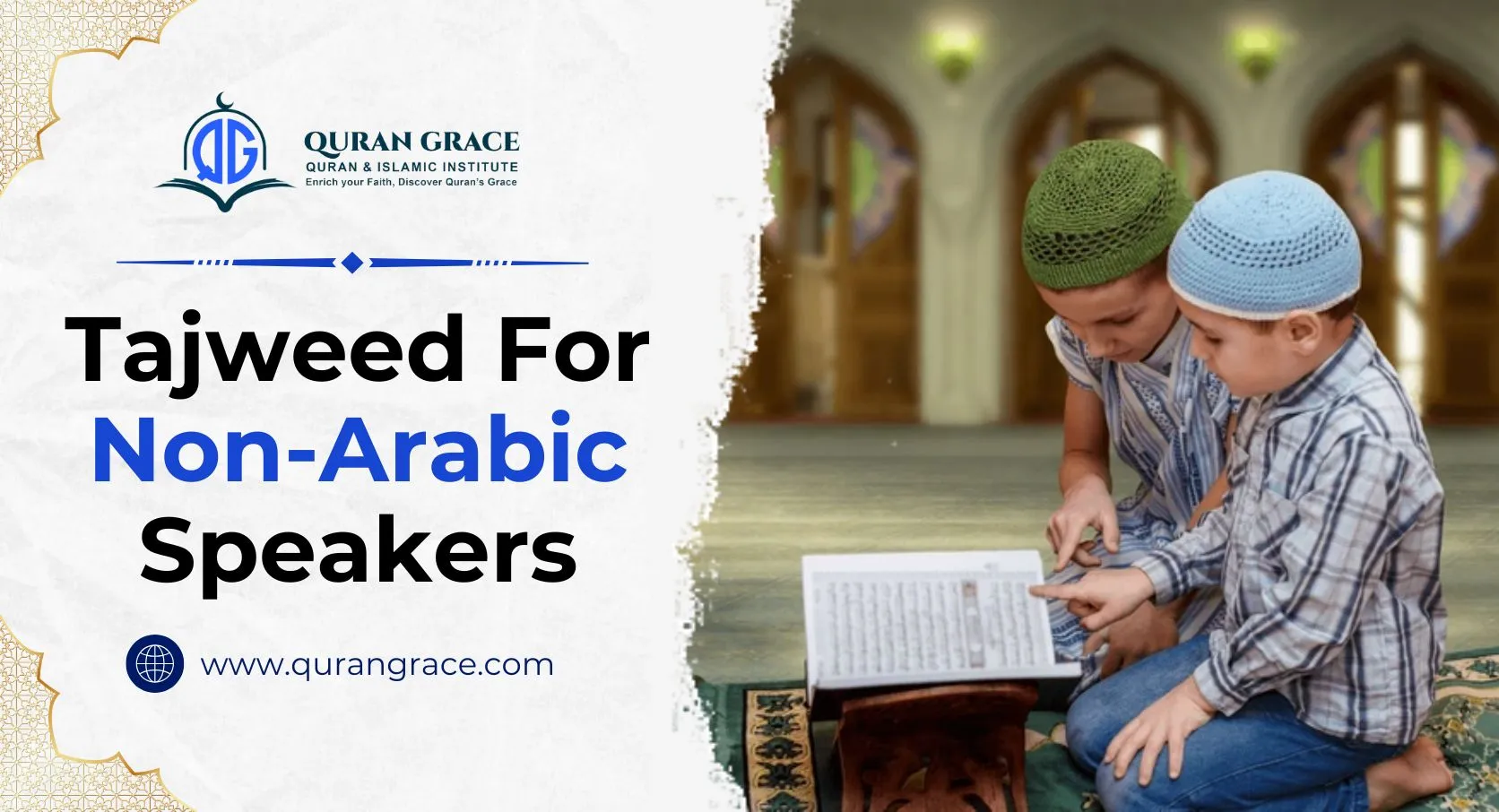Understanding the rules of Tajweed enhances the ability to recite the Quran correctly, especially for non-Arabic learners. The basic 12 Tajweed rules include Qalqalah, Ghunnah, Noon saakinah, Tanween, Meem saakinah, and the rules of Madd. By mastering these basic and essential rules, non-natives can easily read the Quran and try to understand it too. Let’s take a closer look at these essential rules for proper recitation.
Table of Contents
ToggleTajweed Rules for Non-Arabic Speakers
Here are some important tajweed rules shared by “Quran Grace” Egyptian quran teachers for non-Arabic students to understand and learn quran properly.
1. Qalqalah
Qalqalah refers to the jerking or vibrating sound that occurs when certain letters are pronounced with Sukoon, meaning there is no vowel sound (fatha, dammah, or kasrah). Qalqalah enhances the clarity of specific letters in the recitation of the Quran. Its purpose is not only to ensure correct pronunciation but also to enrich the beauty and rhythm of the recitation. There are 5 letters of Qalqalah, usually called Qutbu jadd (ق, ط, ب, ج ,د)
Example: When we read words such as الفلق, خلق, وقب, and كَسَبَ, we must stand on the last letter with a saakin letter and make the sound of qalqalah.
2. Ghunnah
Ghunnah, or nasalization, occurs when airflow is partially diverted through the nose while the vocal cords vibrate. It specifically applies to the letters ن (Noon) and م (Meem), particularly when they have a Shaddah or appear in their Sakinah forms (Noon Sakinah or Meem Sakinah). Ghunnah enhances the recitation of the Quran by adding a rhythmic quality, giving it a special depth and extent.
Example: We make ghunnah when we read the following Quranic words in Surah Al-Asr, “إِنَّ ٱلۡإِنسَـٰنَ لَفِی خُسۡرٍ” ” and also in Surah Al-Qari’ah, “ وَأَمَّا مَنۡ خَفَّتۡ مَوَ زِینُهُۥ “.
3. Noon saakinah and Tanween Rules
Noon Sakinah is a term that refers to the letter ن when it is pronounced without any vowel sound. This signifies a moment of pause where the sound is articulated clearly and distinctly. In contrast, Tanween is comprised of specific diacritical marks that are placed above certain Arabic letters. These marks indicate a nasal ending sound that is immediately followed by a short vowel, enriching the pronunciation of the words.
Mastering both Noon Sakinah and Tanween rules is crucial for anyone studying the Arabic language, as they play a vital role in ensuring the accuracy and clarity of pronunciation. A proper understanding of these concepts helps to prevent mispronunciations done by non-Arabs that could potentially alter the meanings of words. So every non-Arabic Muslim should enroll in online tajweed course with a native Egyptian Quran teacher to learn to read the quran properly.
Example: We follow the rules of noon saakinah and tanween when we read the following Quranic words in surah Az-Zumar, “وَمَنْ يُضْلِلِ اللَّهُ فَما لَهُ مِنْ هاد” and also in surah Al-Baqarah, “أُولئِكَ عَلى هُدىً مِنْ رَبِّهِمْ”.
4. Meem saakinah Rules
Meem Saakinah refers to the letter “Meem” (م) when it appears with a sukoon, whether during a pause or while continuing to read. This specific Meem does not carry any of the three vowels—fatha, kasra, or damma. Mastering the pronunciation of Meem Saakinah is crucial for non-native speakers to ensure the accuracy and elegance of the recitation.
Example: We apply meem saakinah rules when we read this verse in surah Al-Feel “تَرْمِيهِم بِحِجَارَةٍ مِّن سِجِّيلٍ”.
5. Rules of Madd in the Quran
Madd means the prolongation of specific sounds when pronouncing specific letters. There are two types of Madd:
- Madd Asli/Tabi’ee (Natural Madd): Madd Asli has three short vowel marks: Fatha (ـَ), Damma (ـُ), and Kasra (ـِ).
- Madd Far’ee (Secondary Madd): This madd uses vowel elongation with the presence of either Hamza or Sukoon.
Madd is very significant and enhances the beauty and richness of the language.
Example: The following Madd rules are applied when we read the verse in surah Al-Hujrat, “,” and surah Al-Haqqah, “الْحَاقَةُ”.
Why is it so Important for non-Arabic speakers to Learn the Fundamentals of Tajweed?
Learning Tajweed is a crucial journey for non-Arabic speakers who wish to recite the Holy Quran accurately and beautifully. Tajweed plays a vital role in Quranic recitation, as incorrect pronunciation can alter the meanings of the words.
It is mandatory to understand the rules of Tajweed and the sounds of the Arabic language, ensuring they apply them correctly. Non-Arabic speakers often encounter various challenges while learning Tajweed, such as mastering the unique Arabic sounds, vowels, and consonants. Perfecting these sounds demands consistent practice and dedication, and it may take time for learners to become proficient in their pronunciation.
Conclusion
Many individuals who do not speak Arabic are eager to enhance their recitation skills. However, they often encounter challenges in mastering the rules of Tajweed, which are essential for proper pronunciation and articulation. Quran Grace emphasizes the significance of Tajweed for non-Arabic speakers, highlighting the necessity of understanding its foundational rules for accurate recitation. You are welcome to join an advanced tajweed course with a free trial class with one of our Native Egyptian tutors and correct your Tajweed today!








